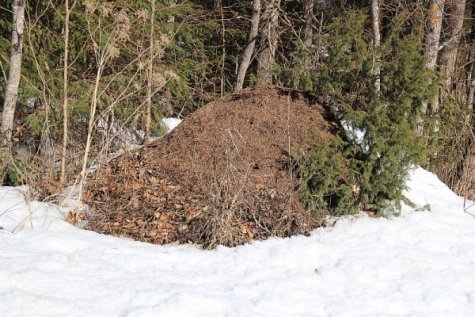Ants already moving in the sun
Photo by Silvi Tanning, Lääne-Virumaa
Translation: Liis
Wood ant nest
Wood ants, mound ants, thatching ants, stack antsMetsauklased Formica sp
In cold the tiny ants cannot keep up their body temperature, and their movements become sluggish, it might even be said that their muscles seize up. During the last weeks there has been a great deal of sun regardless of the cold weather, and it has thawed the snow cover from the ants’ nest stacks: with warm sunshine they have already been seen moving there.
The various Formica species, the reddish-brown wood or mound ants, are among the best-known of our ants, and there are seven species of them in Estonia: Formica rufa (red wood ant or southern wood ant or horse ant); Formica lugubris (hairy wood ant); Formica truncorum (trunk ant); Formica aquilonia (red wood ant or Scottish wood ant);Formica pratensis (black-backed meadow ant); Formica polyctena (red wood ant); Formica nigricans (European red wood ant). They build visible nest stacks from tree needles and twigs binding them with all sorts of plant resins. We can find the mound nests or ant hills in mixed forests, wooded meadows, sometimes in a quiet corner of the garden – where they can be a bother. Ants are very useful creatures and protected species. If they should cause problems near homes, the local environmental services specialists will help you to transport them to a new living site.
Translators note: Most of us probably simply know these ants collectively as wood or forest ants or stack ants. Many insect species do not have generally accepted common names in a language; different common names may be in use, or none even exist at all. So it is with the ants, and so Latin names become necessary for understanding.









